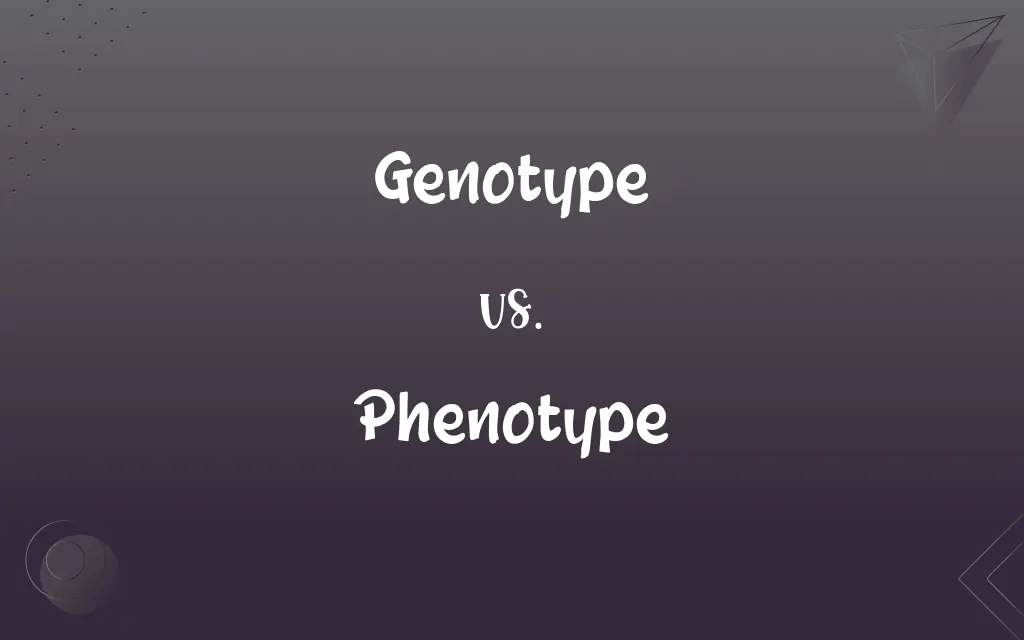Genotype vs. Phenotype: What's the Difference?
Edited by Janet White || By Harlon Moss || Updated on October 30, 2023
Genotype is an organism's genetic makeup; phenotype is its physical appearance or observable traits.

Key Differences
Genotype refers to the genetic composition of an organism, while phenotype denotes the observable characteristics of that organism. Genotype consists of the specific set of genes an individual inherits from its parents. In contrast, phenotype encompasses the visible traits, behaviors, and other observable features of an organism. These traits can range from hair color to the sound of an individual's voice.
Both genotype and phenotype play pivotal roles in the study of genetics. The genotype is essentially the blueprint for an organism, holding the information required to build and maintain that organism. On the other hand, the phenotype is the actual expression of this blueprint, influenced by both genetic factors (genotype) and environmental factors. It's important to note that while an organism's genotype remains constant throughout its life, its phenotype can change due to external influences.
The relationship between genotype and phenotype is dynamic. A single genotype can give rise to multiple phenotypes in different environments. This is evident in cases where identical twins, having the same genotype, may exhibit different phenotypes due to varied environmental factors or experiences. Conversely, different genotypes can sometimes result in the same phenotype, demonstrating the complexity of genetic expression.
In many instances, scientists aim to understand the connection between genotype and phenotype to predict an organism's traits based on its genetic makeup. Through this, the study of genotype and phenotype aids in fields like personalized medicine, agriculture, and conservation biology. Both terms, genotype and phenotype, highlight the intricate relationship between genetics and the environment in determining an organism's characteristics.
Comparison Chart
Definition
Genetic makeup of an organism.
Observable traits of an organism.
ADVERTISEMENT
Source
Inherited from parents.
Result of genotype and environment interaction.
Changeability
Constant throughout life.
Can change based on environmental factors.
Representation
Alleles (gene versions) e.g., AA, Aa, aa.
Physical traits e.g., blue eyes, tall stature.
Influence
Determines potential traits.
Actual expression of traits.
Genotype and Phenotype Definitions
Genotype
The inherited instructions an organism carries.
The plant's genotype held the information for producing purple flowers.
ADVERTISEMENT
Phenotype
The expression of an organism's genotype in its environment.
The plant's green color is a result of its phenotype.
Genotype
An individual's unique gene sequence.
Studying the genotype helps in understanding genetic variations.
Phenotype
The manifestation of genetic and environmental influences.
Nutrition can influence the phenotype, like height in humans.
Genotype
The genetic constitution of an organism.
The genotype determined the potential for blue eyes.
Phenotype
The set of visible characteristics of an individual.
Her curly hair is a distinctive phenotype.
Genotype
The specific allelic composition of a cell.
The genotype of the cell was homozygous recessive.
Phenotype
The physical and observable traits of an organism.
His tall stature is a part of his phenotype.
Genotype
The set of genes carried by an individual.
Her genotype includes the gene for red hair.
Phenotype
The detectable expression of a genotype.
The flower displayed a pink phenotype, hinting at its genetic makeup.
FAQs
How is phenotype different from genotype?
Phenotype is the observable traits, while genotype is the genetic composition.
What is a genotype?
Genotype refers to the genetic makeup of an organism.
Are identical twins' genotypes the same?
Yes, identical twins share the same genotype.
Can environmental factors influence phenotype?
Yes, phenotype can be influenced by both genetics and the environment.
Can the genotype of an organism change?
No, the genotype remains constant throughout an organism's life.
What tools help in determining an organism's genotype?
Genetic testing and sequencing techniques are commonly used.
Is the study of genotype important in medicine?
Yes, understanding genotype can help in personalized medicine and predicting genetic diseases.
How do scientists study the relationship between genotype and phenotype?
Through genetic and environmental research, often using model organisms.
Why might two plants of the same genotype look different?
Different environmental conditions can lead to varied phenotypic expressions.
Why might a person's phenotype change over time?
Environmental factors, lifestyle choices, and other external influences can alter an individual's phenotype.
How do mutations affect genotype and phenotype?
Mutations alter the genotype, which can, in turn, influence the phenotype.
Are genotype and phenotype concepts only applicable to humans?
No, they apply to all organisms with genetic material.
How are genotype and phenotype related?
Genotype determines potential traits, while phenotype displays the actual expression of these traits.
Can two organisms have the same phenotype but different genotypes?
Yes, various genetic makeups can lead to similar observable traits.
Are all aspects of phenotype visible?
No, some aspects of phenotype, like blood type, aren't readily visible.
Can a single gene influence multiple phenotypic traits?
Yes, this is known as pleiotropy.
How does genetic dominance influence phenotype?
Dominant alleles can mask the effect of recessive ones, influencing the phenotypic outcome.
Can different genotypes produce the same phenotype?
Yes, different genetic compositions can sometimes result in the same observable traits.
Can a person's genotype predict their phenotype?
To some extent, yes, but environmental factors also play a significant role.
How can genotype information be used in breeding programs?
It helps in predicting and selecting desired traits in offspring.
About Author
Written by
Harlon MossHarlon is a seasoned quality moderator and accomplished content writer for Difference Wiki. An alumnus of the prestigious University of California, he earned his degree in Computer Science. Leveraging his academic background, Harlon brings a meticulous and informed perspective to his work, ensuring content accuracy and excellence.
Edited by
Janet WhiteJanet White has been an esteemed writer and blogger for Difference Wiki. Holding a Master's degree in Science and Medical Journalism from the prestigious Boston University, she has consistently demonstrated her expertise and passion for her field. When she's not immersed in her work, Janet relishes her time exercising, delving into a good book, and cherishing moments with friends and family.































































